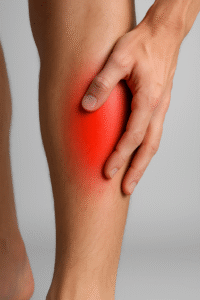If your shins hurt when you run, you are definitely not alone. Many runners feel that sharp, burning, or tight pain along the lower leg. Although it can be worrying, the cause is usually simple. Additionally, most cases respond well to a few easy changes. Therefore, you can fix the issue quickly and get back to running comfortably.
1. The Most Common Reason: Shin Splints
Shin splints are the top reason runners feel shin pain. They appear when the tissues and muscles around the shin bone become irritated. Because this area absorbs impact every time you land, it can overload easily.
Signs you may have shin splints include:
-
Aching or burning along the front or inside of the shin
-
Pain early in a run that sometimes eases later
-
Tenderness when pressing the area
-
Tightness around the lower leg
Although the pain is annoying, it is usually a sign that your body needs more support and less stress.
2. Why Shin Splints Actually Happen
Shin pain rarely appears for no reason. Instead, it comes from a few predictable triggers.
You increased training too quickly
Your legs need time to adapt. When mileage jumps suddenly, tissues struggle to cope. As a result, pain develops.
Your form needs small adjustments
Over-striding and heavy landings increase impact. Additionally, low cadence can overload the tibia.
Your shoes are worn out or unsuitable
Old shoes lose cushioning. Meanwhile, the wrong shoes change your mechanics. Both issues increase stress on the shins.
Your lower legs are weak
Weak calves, ankles, or tibialis muscles force bones and tissues to absorb extra force. Consequently, irritation appears.
You’re running mainly on hard surfaces
Concrete and tarmac increase impact. Softer surfaces often reduce pain.
You’re new to running
Your legs simply need time to adapt to repetitive impact. However, this improves with consistent training.
3. Other Possible Causes (Less Common, Still Important)
1. Stress fracture
A stress fracture causes sharp, localised pain that worsens with running. Because it’s serious, you should rest and seek medical advice.
2. Tendon irritation
Overuse of tendons around the ankle or shin can create sharp discomfort. Additionally, speed sessions and hills often trigger this.
3. Compartment syndrome
This causes intense pressure during running that eases when you stop. Although rare, it needs proper assessment.
If the pain persists during walking or worsens daily, get it checked.
4. How to Fix Shin Pain Quickly
1. Reduce your training load
Lower mileage by 20–40% for a short period. Although it feels frustrating, it allows tissues to recover. Additionally, it prevents the issue becoming serious.
2. Upgrade or replace your running shoes
If your shoes have more than 300–500 miles, replace them. New shoes often reduce pain immediately. Furthermore, switching to a slightly more cushioned model can help.
3. Strengthen your lower legs
Even a few minutes of strength work helps.
Try:
-
Toe raises
-
Tibialis raises
-
Calf raises
-
Heel drops
-
Resistance band ankle work
Because stronger muscles absorb more impact, your shins take less stress.
4. Improve your running form
Small tweaks make a big difference.
-
Increase cadence (170–180 steps per minute)
-
Shorten your stride
-
Land under your centre of mass
-
Relax your ankles
As a result, you run lighter and reduce shock.
5. Switch surfaces
Run on grass, dirt, or a track when possible. Softer ground absorbs more impact. Additionally, switching surfaces keeps training more enjoyable.
6. Ice the area after running
Apply ice for 10–15 minutes to reduce irritation. Although simple, it often speeds up recovery.
7. Stretch tight calves
Tight calves pull on the tissues around the shin. Therefore, flexibility helps relieve tension.
5. How to Prevent Shin Pain From Returning
Once shin pain improves, it’s important to keep it away.
-
Increase distance gradually
-
Keep your cadence high
-
Strength train twice per week
-
Rotate shoes if possible
-
Warm up properly every session
-
Mix soft and hard surfaces
-
Pay attention to early warning signs
Because prevention is easier than rehab, these habits save time and frustration.
6. When to Seek Professional Help
Although most shin pain improves with simple changes, you should seek help if:
-
Pain is sharp or worsening
-
You feel pain during daily walking
-
The area swells or feels hot
-
Symptoms last more than 2–3 weeks
-
You suspect a stress fracture
If in doubt, always get it checked. Early treatment prevents longer downtime.
Final Thoughts
Shin pain is common, but it doesn’t have to last. Once you understand the cause — usually overload, weak lower legs, or poor footwear — you can fix it quickly. Additionally, with better strength, smarter pacing, and steady mileage increases, you can prevent it from returning. Stay patient, train smart, and let your shins settle. Your running will feel smoother, easier, and far more enjoyable.
